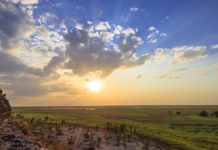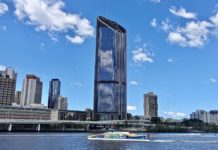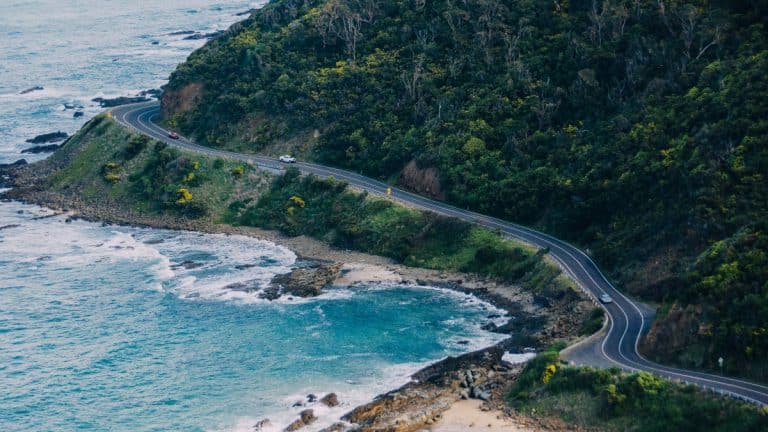
Considered as one of the most beautiful roads in the world, the winding Great Ocean Road stretches from Torquay to Warrnambool, occupying the southwestern part of the state of Victoria. Here is our recommended Great Ocean Road itinerary. Along this 250km stretch of road, there are charming small coastal towns, breathtaking rock formations, including the famous Twelve Apostles, and beautiful beaches with turquoise waters. The part of the coast spanning from Princetown to Port Fairy is nicknamed the Shipwreck Coast because of the number of shipwrecks its sharp cliffs caused.
This incredible route is worth visiting for about 2 to 3 days. We give you the must-see sights of this legendary road and our practical recommendations for a unique experience.
Table of Contents
How to get to the Great Ocean Road?
The Great Ocean Road stretches from Torquay to Warrnambool for nearly 250km. You can go there from Melbourne or Adelaide. The ideal is to travel with your vehicle and plan 2 or 3 days to explore it. You can also rent a vehicle (campervan or car) from Melbourne or Adelaide for a few days to discover the region. For those who don’t have much time, you can still get an overview in 1 day from Melbourne.
If you do not have a vehicle and do not want to rent one, there are also organized tours of 1 to 3 days from Melbourne or Adelaide.
Best season to visit the Great Ocean Road
| Season | Months | Highlights | Tips |
|---|---|---|---|
| Autumn | Mar–May | Mild days (15–22 °C), fewer crowds, clear skies | Ideal for photography; book accommodation early. |
| Winter | Jun–Aug | Whale season (Jun–Sep), dramatic storms | Pack warm layers and rain gear; strong SW winds possible. |
| Spring | Sep–Nov | Wildflowers bloom, baby wildlife | Weekdays best for quiet walks; watch for snakes on trails. |
| Summer | Dec–Feb | Warm beach days (20–26 °C), surf season | Arrive early to avoid parking shortages at popular lookouts. |
The ideal season to visit this region is from September to February. Remember that during the school holidays there are many tourists, which can sometimes spoil the visit a little.
From Torquay to Apollo Bay (154 km)
Memorial Arch
Located right at the start of the Great Ocean Road, as you head from Melbourne. This archway pays tribute to the construction of this famous drive. The Great Ocean Road Memorial Arch is dedicated to the returning World War I Servicemen of Australia that built the road in 1932. This is the third memorial arch built, but it’s a fascinating piece of history nonetheless.
Torquay & Bells Beach
Start at Surf Coast’s birthplace of surfing—watch pros at the Rippable surf park or Bells Beach lookout. Visit the Surfworld Australia Surfing Museum in the center of town ($10 / pers.) and the surrounding beaches. The renowned surfing beach Bells Beach (one of the film locations for Point Break), located a few miles from town, is a must-stop when visiting Torquay.
Located near Torquay, Bells Beach is one of Australia’s most famous surfing beaches, known for its powerful swells and the prestigious Rip Curl Pro surfing competition. Even if you’re not a surfer, the beach’s dramatic cliffs and ocean views are a sight to behold. Come at Easter time and enjoy the Rip Curl Pro Event. Or just watch the locals braving their luck in the cold water.
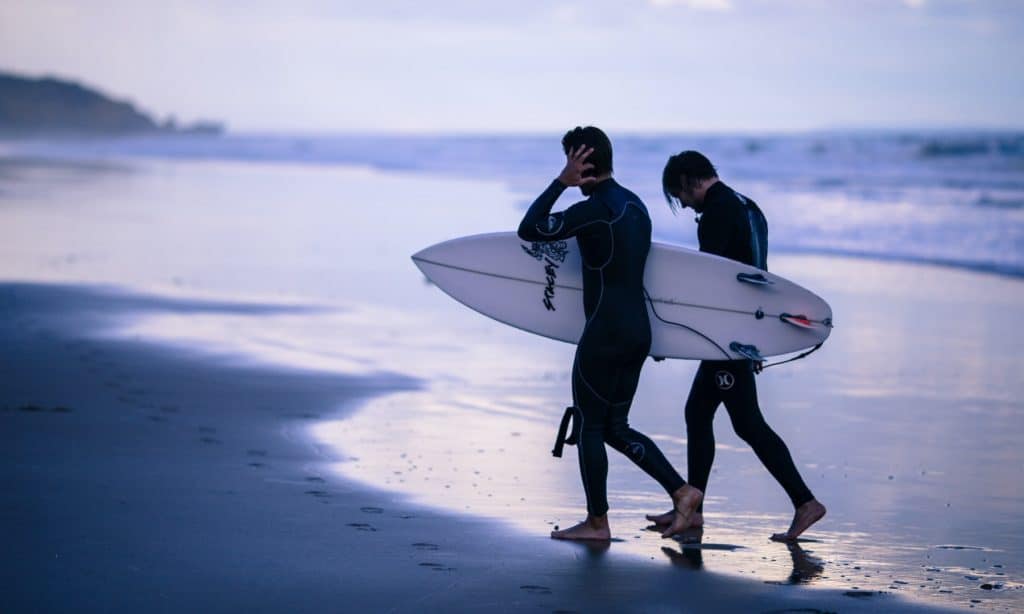
Anglesea Koala Trail (Free)
Short detour into the golf-course reserve for early-morning koala sightings.
Aireys Inlet, Lighthouse
A little past Torquay is Aireys Inlet. The walk to access the lighthouse begins with a pretty river that opens onto the sea. It is possible to go canoeing there, the place is very peaceful. A few meters higher, we reach the lighthouse with other paths available to admire the ocean view from different heights. There is an isolated rock in the middle of the water, the Eagle Rock Marine Sanctuary. Guided tours (AUD 20) of the octagonal 1891 lighthouse; book sunset sessions for golden views.
Lorne
The little town of Lorne is a lovely place to stop for a few hours or even spend the night. There is plenty of nearby waterfalls to walk to. You can enjoy an active and outdoorsy exploration of the area on foot.
Located near Lorne, Teddy’s Lookout offers one of the best vantage points along the Great Ocean Road. Walk 1 km return to panoramic coastal vistas. From here, you can enjoy breathtaking views of the Saint George River and the coastline stretching towards Apollo Bay.
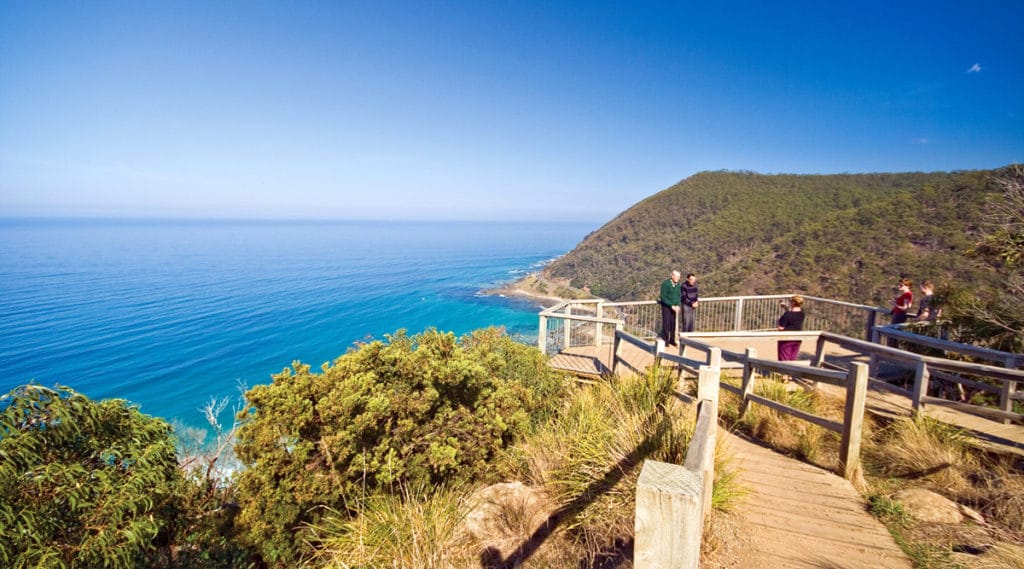
Cumberland River Trail (20.5 km)
Very close to Lorne and with a departure from the Cumberland River Holiday Park, this walk takes about 6h30 return. Even if it is on a tourist route, this hike is very pleasant. The path follows the winding river which is interrupted around the first 3 kilometers by a natural swimming pool (Jebb’s Pool). A few more kilometers further you can admire the source of a waterfall. The hike then continues along a long path dotted with rivers, natural pools, flowers and trees of all kinds. Many animals can be seen in the wild; kangaroos, snakes and birds in particular.
Kennet River
Kennett River on the Great Ocean Road is one of the best places in Australia to spot wild koalas. Take a stroll along the Grey River Road, and look up to see these adorable creatures in their natural habitat. So we certainly recommend heading here if you’re yet to tick spotting one of these grey, fluffy creatures off your bucket list.
And they’re easy to spot too. Just pull up your vehicle next to the rest of the tourists and follow the gaze of their pointing fingers and snapping lens. Yes, sometimes popular tourist spots can have their advantages!

From Apollo Bay to Port Campbell (124 km)
Apollo Bay
A picturesque seaside town, Apollo Bay is a great place to relax on the beach, enjoy fresh seafood, and explore the nearby Otway Ranges. It’s also a popular spot for water sports, including surfing, kayaking, and seal and dolphin watching tours. About 1km from town, Mariner’s Lookout offers spectacular views.
Great Otway National Park
Johanna is a tiny town but its beach is definitely worth a visit! A little further, the Cape Otway National Park offers beautiful landscapes with walks amongst giant trees.
This diverse national park spans from the hinterlands to the coast, featuring ancient rainforests, waterfalls, and rugged coastline. Highlights include the Cape Otway Lightstation, Australia’s oldest surviving lighthouse, and the Otway Fly Treetop Adventures, offering a unique perspective of the rainforest canopy. Triplet Falls (1.2 km loop) and Rainforest Picnic Area—permit-free day use.
There’s also some great, budget-friendly camping spots located within the park, as well as some super hiking opportunities. Including the 243 km Great Ocean Walk!
The Great Ocean Road’s only lighthouse, also known as the Cape Otway Lightstation (Entry AUD 25), lays claim to being Australia’s most important lighthouse. It guards one of the country’s most treacherous coastlines and was built after hundreds of lives were lost from numerous shipwrecks. As such, it is Australia’s oldest surviving lighthouse and invites visitors to enjoy the breathtaking views from its observation deck. There is also an excellent interpretive Centre and indigenous Cultural Centre, which also make a visit here highly worthwhile.
Port Campbell National Park
This is the next stop on our Great Ocean Road itinerary. The Twelve Apostles are the most famous rock formations on the Great Ocean Road. These limestone towers, some of which are more than 45m high, seem to watch over the coast, constantly changing with the breaking waves coming from Antarctica. Forces of winds and tides have been shaping these rocks for centuries and have gradually eroded the smallest rock formations. Today there are only 8 out of the 12 limestone towers left. You can admire them from one of the observation platforms accessible from the car parks. You can even go down to the beach to see the rocks from below, a different and amazing view.
There are also other ways to observe the Twelve Apostles, it is quite possible to fly over them in a helicopter!

East of the Twelve Apostles, Wreck Beach marks the beginning of a walking track that takes you to the anchors of two ships stranded there at the end of the 19th century.
A little further down the road, Loch Ard Gorge is a place filled with history. Named after a shipwreck that occurred in 1878, Loch Ard Gorge is a stunning example of the power of erosion. The gorge features clear blue waters, towering cliffs, and sandy beaches, making it a perfect spot for photography and exploration. This beach has been made famous by the ship that ran aground on nearby Muttonbird Island. The incredible survival story of the 2 teenage passengers is wonderfully told in the landscape around. It must have been terrifying.
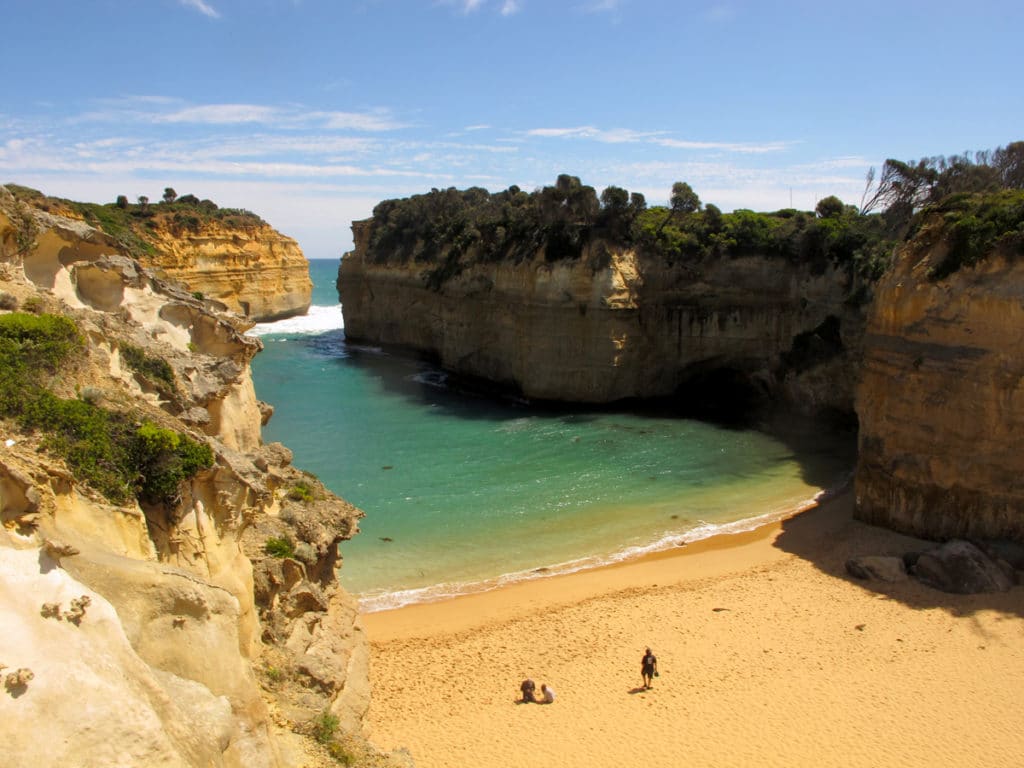
At the Bay of Martyrs, a group of small islands separated from shore by less than 100m, another tragedy occurred. A long time ago, white farmers settled in this area, taking land from the traditional landowners. No longer able to hunt on their land, the Aborigines began to kill farm animals. Subsequently, war broke out, which led farmers to tragically capture aborigines and throw them off the cliffs.

From Port Campbell to Warrnambool (108 km)
Port Campbell
Port Campbell is a very pretty village, however quite touristy. This is a prefect place to stop for refueling, shopping, or even having a picnic on the beach. The Discovery Walk is a great opportunity to enjoy the view of the bay from high up.
Originally a natural archway and tunnel in the limestone, London Arch collapsed in 1990, leaving a freestanding stack. The site tells a fascinating geological story and offers spectacular views of the coast.
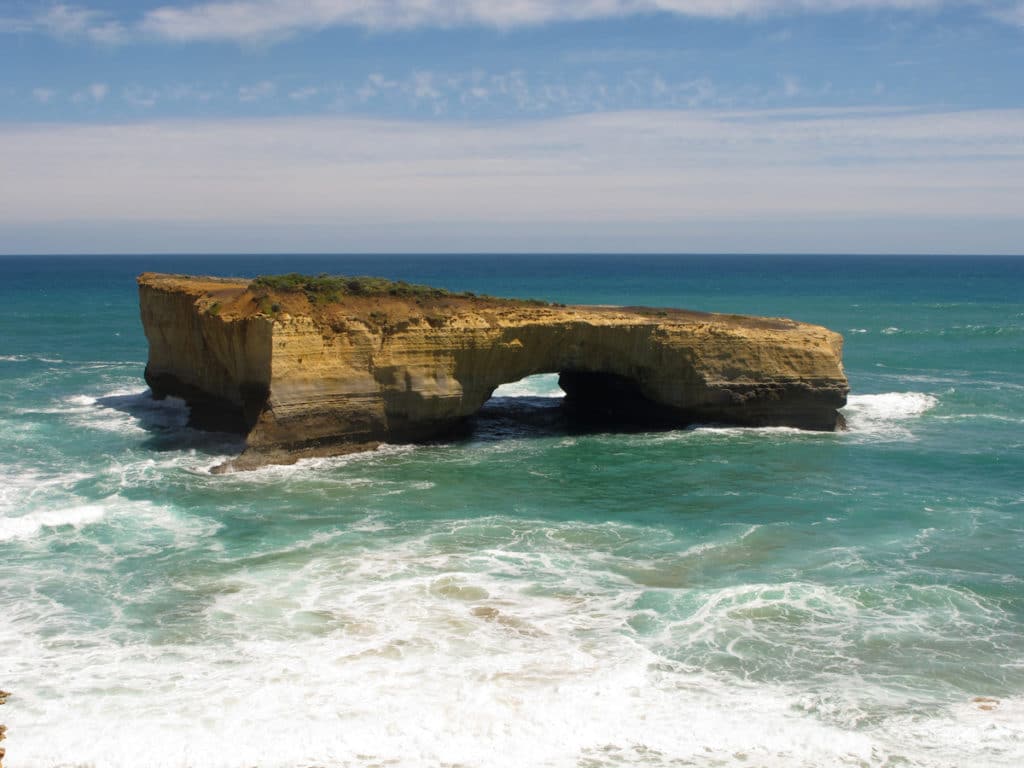
Warrnamboll
Largest town on the Great Ocean Road, Warrnamboll has shopping malls, hotels, and even a nursery for whales! The town’s beach, Logans Beach, is the playground of the Southern Right Whales, which pass by every year between June and October.
Check out the Flagstaff Hill Maritime Village (Entry AUD 24) or the free Warrnambool Botanic Gardens.
The Great Ocean Walk
Doing this hike is a great way to be closer to nature than just as a spectator and to experience this stunning coastline differently. It stretches over 104km from Apollo Bay to the Twelve Apostles. Crossing beautiful parks and deserted beaches, it is possible to start and stop the walk wherever you want. It is strongly recommended to be used to hiking and in a good physical condition. If you want to do this unique walk, find more information on the Great Ocean Walk website. This is also the last stop on our Great Ocean Road itinerary.
Exploring the Great ocean Road in 3 days: an unforgettable journey
Day One: Torquay to Apollo Bay
Start you trip from Melbourne, capital of Victoria. There’s still a fair bit of driving along the way to Apollo Bay but you can take quite a few breaks on the way. Your first stop must be at the little surf town of Torquay – one of the best places to surf. Visit the famous Bells Beach, renowned for its world-class waves and the annual Rip Curl Pro surfing competition.
Drive to Lorne, a picturesque seaside town perfect for a leisurely lunch and a stroll along the beach. Then drive on to Apollo Bay which is the destination for your first night. The scenery is stunning and the road winds its way down south hugging the coast so you’re never short on beautiful landscapes to admire on the way.
🏨 Our picks for Hotels at Apollo Bay
Here is what we recommend depending on your budget:
- Best High budget hotel : Seafarers Getaway
- Best mid-range hotel : Sandpiper Hotel Apollo Bay
- Backpackers Hostel : Apollo Bay Backpackers
Day Two: Apollo Bay to Port Campbell
Day two is the big sight-seeing day as it will include Cape Otway and the 12 Apostles which is the most famous part of the route.
Spend your morning exploring the Great Otway National Park. Walk among the ancient, towering trees at the Otway Fly Treetop Adventures or take a hike to the Beauchamp Falls for a serene experience amidst nature.
First off- definitely go to Cape Otway! It’s a detour off the main route but well worth it. As you drive down the road keep your eyes peeled for a glimpse of koalas. Also at the end of the road is a nice lighthouse.
Then continue on to the Twelve Apostles – a misleading name if ever there was one. The best place to view them is from the little beach to the left of them. You can access it by walking down the steps beside the cliff.
After this go to see the Bay of Islands. It is even better than the 12 Apostles. The best time to go is at sunset as the whole bay looks like it’s going up in fire. You can sit on the beach and watch the sun go down. Another great picnic spot amongst the thousands on the route.
Stay overnight in Port Campbell, a charming fishing village near the Twelve Apostles. Enjoy the local hospitality and prepare for the final day of your journey.
Day Three: Port Campbell to Warrnambool
Start your day exploring the Shipwreck Coast, home to over 600 shipwrecks. Visit the Loch Ard Gorge, the site of one of Australia’s most famous shipwrecks, and learn the tales of survival and tragedy at the Shipwrecked Sound and Laser Show in Warrnambool.
In the afternoon, drive to the Tower Hill Wildlife Reserve, an extinct volcano now teeming with Australian wildlife. Here, you can encounter koalas, emus, kangaroos, and various bird species in their natural habitat.
Conclude your Great Ocean Road adventure in Warrnambool. Reflect on your journey with a relaxing evening at the beach or explore the town’s vibrant dining scene.
Practical Driving Tips
- Fuel: Fill up in Apollo Bay and Port Campbell; limited options beyond these towns.
- Speed & Wildlife: 90 km/h on most rural sections; watch for kangaroos at dawn/dusk.
- Mobile Coverage: Telstra offers the widest 4G coverage; expect black spots in Otways.
- Vehicle Prep: Ensure your rental agreement allows for the GOR—check insurance for coastal salt spray.
Great Ocean Road: Travel Information
There are different spots along the road, where you can spend the night for free in your vehicle. To find them, it is best to use the Camps guide or the WikiCamps app. You also find caravan parks.
For van rentals you can compare offers on www.motorhomerepublic.com
For car rentals: www.airportrentals.com
One of the star attractions on the Great Ocean Road is the helicopter tour over the 12 Apostles. You can book it on site or online. A 15-minute flight costs about $300. For more info: 12 Apostles Helicopters




















